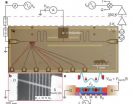(Press-News.org) ANAHEIM, Calif. — Screening for cervical cancer was low among women who self-identified as lesbian — a finding that places them at a potentially elevated risk for the disease, according to data presented at the 11th Annual AACR International Conference on Frontiers in Cancer Prevention Research, held here Oct. 16-19, 2012.
"Despite our knowledge of the value of Pap testing for early detection of treatable cervical abnormalities, lesbians are one subset of women who are not getting screened at recommended rates. In fact, nearly 38 percent of lesbians in our study had not been screened according to recommended guidelines," said J. Kathleen Tracy, Ph.D., associate professor in the department of epidemiology and public health at the University of Maryland School of Medicine in Baltimore.
She and her colleagues conducted a standardized internet survey that examined recent cervical cancer screening behaviors and perceived screening barriers. They sent the survey to 3,000 self-identified lesbians in the United States and received 1,006 responses.
A total of 62 percent of the weighted sample underwent routine screenings. The most common reasons for lack of screening were no physician referral (17.5 percent) and absence of a physician (17.3 percent).
After adjustment for age, education, relationship status, employment status and insurance status, women who disclosed sexual orientation to their primary care physicians were 2.8 times more likely to undergo routine screening compared with women who did not disclose. Similarly, those who disclosed to their gynecologists were 2.3 times more likely to undergo routine screening.
"When this finding is coupled with that of the potency of provider recommendation, it underscores how critical effective communication between patient and provider is for optimal health and disease prevention," Tracy said.
In addition, women who knew that not having a Pap test is a risk factor for cervical cancer were nearly two times more likely to undergo routine screening. No association with screening was found for women who had additional information about general cervical cancer risk factors.
"This study highlights an often overlooked cancer disparity," Tracy said. "We know that human papillomavirus can be transmitted during same-sex sexual activity, so lesbians are at risk for developing cervical cancer. If this group of women doesn't participate in screening, they are at elevated risk for developing cervical cancer via missed opportunities to identify and treat precursor abnormalities."
### The study was funded by the National Cancer Institute.
Follow the AACR on Twitter: @aacr #aacr
Follow the AACR on Facebook: http://www.facebook.com/aacr.org
About the American Association for Cancer Research
Founded in 1907, the American Association for Cancer Research (AACR) is the world's first and largest professional organization dedicated to advancing cancer research and its mission to prevent and cure cancer. AACR membership includes more than 34,000 laboratory, translational and clinical researchers; population scientists; other health care professionals; and cancer advocates residing in more than 90 countries. The AACR marshals the full spectrum of expertise of the cancer community to accelerate progress in the prevention, biology, diagnosis and treatment of cancer by annually convening more than 20 conferences and educational workshops, the largest of which is the AACR Annual Meeting with more than 17,000 attendees. In addition, the AACR publishes seven peer-reviewed scientific journals and a magazine for cancer survivors, patients and their caregivers. The AACR funds meritorious research directly as well as in cooperation with numerous cancer organizations. As the scientific partner of Stand Up To Cancer, the AACR provides expert peer review, grants administration and scientific oversight of team science and individual grants in cancer research that have the potential for near-term patient benefit. The AACR actively communicates with legislators and policymakers about the value of cancer research and related biomedical science in saving lives from cancer.
For more information about the AACR, visit www.AACR.org.
Abstract:
A03 Understanding cervical cancer screening among lesbians: a national survey. J Kathleen Tracy. University of Maryland School of Medicine, Baltimore, MD.
Objectives: The aim of this study was to examine cervical cancer screening behaviors among lesbians in the US, a population who has documented low rates of cervical cancer screening, despite their risk of contracting the disease.
Procedures: A standardized internet survey was sent to 3,000 self-identified lesbians across the US. The survey assessed the participants' recent cervical cancer screening behaviors and perceived barriers to screening.
Results: The sample consisted of 1,006 respondents, representing every region of the US. Sixty-two percent of the weighted sample were routine screeners. Lack of a physician referral (17.5%) and lack of a physician (17.3%) were the most commonly-cited top reasons for lack of screening. Adjusting for age, education, relationship status, employments status, and insurance status, women who had disclosed their sexual orientation to their primary care physician (adjusted odds ratio [OR] 2.84 [95% confidence interval 1.82-4.45]) or gynecologist (OR 2.30 [1.33-3.96]) had greater odds of routine screening than those who did not. Those who knew that lack of Pap testing is a risk factor for cervical cancer were also more likely to be routine screeners (OR 1.95 [1.30-2.91]), although no association with screening was apparent for women who had more knowledge of general cervical cancer risk factors. Physician recommendation appeared to be a potent determinant of regular screening behavior. Routine screeners perceived more benefits and fewer barriers to screening, and higher susceptibility to cervical cancer, than did women who did not routinely screen.
Conclusions: Women who identify as lesbian are at potentially elevated risk of cervical cancer because they are not routinely screened. Evidence-based interventions should be developed that address critical health beliefs that undermine participation in screening. Given the value placed on physician recommendation, patient-provider communication may serve as the optimal mode for intervention delivery.
ANAHEIM, Calif. — Achieving and maintaining a healthy body weight, staying physically active and maintaining a healthy diet improved survival after cancer diagnosis in an elderly female cancer survivor population, according to data presented at the 11th Annual AACR International Conference on Frontiers in Cancer Prevention Research, held here Oct. 16-19, 2012.
Researchers examined cancer survivors' adherence to the 2007 World Cancer Research Fund/American Institute for Cancer Research (WCRF/AICR) guidelines for body weight, physical activity and diet.
"Elderly female ...
San Diego, CA (October 17, 2012) – A sweeping study on the issue of antibiotic-resistant bacteria in hospitals shows that using antimicrobial soap and ointment on all intensive-care patients significantly decreases bloodstream infection. The results, which are being presented for the first time at IDWeek 2012TM, may suggest a major change in health care practice that could help save lives.
The study involved nearly 75,000 patients in 43 mostly community hospitals in 16 states and involved each hospital's own quality improvement team. Working with these teams enabled ...
SEATTLE – One of the world's leading bone marrow transplant experts is recommending a significant change to current transplant practice for patients who need marrow or adult stem cells from an unrelated donor to treat hematologic malignancies. Fred Appelbaum, M.D., director of the Clinical Research Division at Fred Hutchinson Cancer Research Center, asserts that bone marrow – not circulating, peripheral blood, which is the current norm – should be the source for unrelated donor adult stem cells for most patients who require a transplant. The reason: because there is less ...
Ustekinumab, an antibody proven to treat the skin condition psoriasis, has now shown positive results in decreasing the debilitating effects of Crohn's Disease, according to researchers at the University of California San Diego, School of Medicine. The study will appear in the October 18, 2012 issue of the New England Journal of Medicine (NEJM).
Results from the clinical trial showed ustekinumab (Stelara) increased clinical response and remission in patients suffering from moderate-to-severe Crohn's Disease - a form of inflammatory bowel disease (IBD) that can lead ...
Qubit-based computing exploiting spooky quantum effects like entanglement and superposition will speed up factoring and searching calculations far above what can be done with mere zero-or-one bits. To domesticate quantum weirdness, however, to make it a fit companion for mass-market electronic technology, many tricky bi-lateral and multi-lateral arrangements---among photons, electrons, circuits, cavities, etc.---need to be negotiated.
A new milestone in this forward march: a Princeton-Joint Quantum Institute (JQI) collaboration announces the successful excitation ...
ANAHEIM, Calif. – Oct.17, 2012. Nearly 38 percent of lesbians polled in a national survey were not routinely screened for cervical cancer, putting them at risk of developing a highly preventable cancer, according to a University of Maryland School of Medicine study being presented at the 11th Annual AACR International Conference on Frontiers in Cancer Prevention Research. Cervical cancer is caused by a sexually transmitted virus, the human papillomavirus (HPV), and can be detected through regular Pap smears.
The percentage of lesbians not being screened as recommended ...
The giant impact believed to have formed the Earth-Moon system has long been accepted as canon. However, a major challenge to the theory has been that the Earth and Moon have identical oxygen isotope compositions, even though earlier impact models indicated they should differ substantially. In a paper published today in the journal Science online, a new model by Southwest Research Institute (SwRI), motivated by accompanying work by others on the early dynamical history of the Moon, accounts for this similarity in composition while also yielding an appropriate mass for Earth ...
It's a big claim, but Washington University in St. Louis planetary scientist Frédéric Moynier says his group has discovered evidence that the Moon was born in a flaming blaze of glory when a body the size of Mars collided with the early Earth.
The evidence might not seem all that impressive to a nonscientist: a tiny excess of a heavier variant of the element zinc in Moon rocks. But the enrichment probably arose because heavier zinc atoms condensed out of the roiling cloud of vaporized rock created by a catastrophic collision faster than lighter zinc atoms, and the remaining ...
SANTA CRUZ, CA--Among the oddities of the outer solar system are the middle-sized moons of Saturn, a half-dozen icy bodies dwarfed by Saturn's massive moon Titan. According to a new model for the origin of the Saturn system, these middle-sized moons were spawned during giant impacts in which several major satellites merged to form Titan.
Erik Asphaug, professor of Earth and planetary sciences at the University of California, Santa Cruz, will present this new hypothesis October 19 at the annual meeting of the Division for Planetary Sciences of the American Astronomical ...
It takes both teeth and jaws to make a pretty smile, but the evolutionary origins of these parts of our anatomy have only just been discovered, thanks to a particle accelerator and a long dead fish.
All living jawed vertebrates (animals with backbones, such as humans) have teeth, but it has long been thought that the first jawed vertebrates lacked pearly gnashers, instead capturing prey with gruesome scissor-like jaw-bones.
However new research, led by the University of Bristol and published today in Nature, shows that these earliest jawed vertebrates possessed teeth ...


